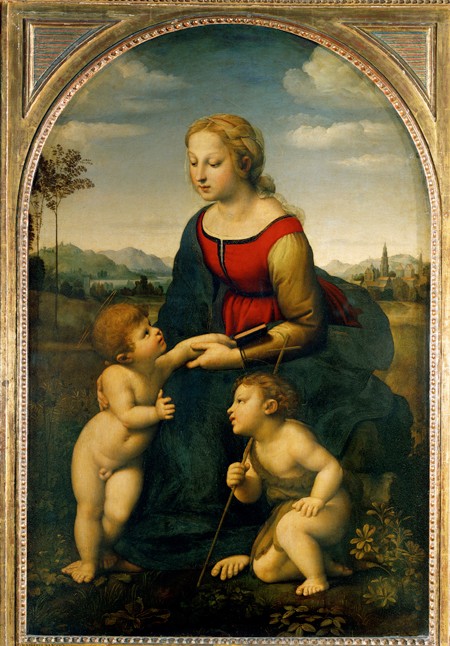The scholarly paradigm of “Renaissance rivals”—towering geniuses
competing—has fruitfully described some interactions between, for example, Michelangelo (1475–1564) and Leonardo da Vinci (1452–1519). Yet it fails to capture many achievements of their contemporary Raphael (1483–1520), who was known for making his colleagues feel (in Giorgio Vasari’s words) “naturally united and in . . . accord.” I explore Raphael’s artistic collaborations, but not only through a connoisseurial assigning of individual hands within a group project.
Members' Research Report Archive
Raphael and the Renaissance Arts of Collaboration
Lisa Pon, Southern Methodist University
Paul Mellon Visiting Senior Fellow, January 4–March 7, 2017

Raphael, Madonna and Child with Saint John the Baptist (La Belle Jardinière). Musée du Louvre. Photograph: Erich Lessing / Art Resource, NY
Scholarship has traditionally recognized Raphael’s many collaborations but has tended to understand his participation in these jointly produced projects in terms of his master design being executed, well or poorly, by others. Whereas this approach has generally seen Raphael’s ideas as materialized incompletely by craftsmen unable to achieve his ideal artistic vision, recent studies in contemporary art history and media theory have offered ways of understanding transmedial collaborations that are both more nuanced and more congruent with how Raphael worked with his partners. For instance, Rosalind Krauss’s description of contemporary art’s postmedium condition emphasizes technical supports over physical materials and encourages us to look beyond any single “pure” medium, such as sculpture, and to embrace instead the media heterogeneity characteristic of the late twentieth century. Media theorist Henry Jenkins’s work on transmedial narratives shows that character development can occur simultaneously on a variety of media platforms, rather than always beginning in a book and then moving on to other forms.
It is important to understand that Raphael’s own design process likewise revolutionized artistic production, which in his time had followed a one-way sequence from “first-thought” (primo pensiero) sketches, through drawings of individual and grouped figures and small compositional studies, to reach full-size cartoons and ultimately a finished painting. But Raphael deviated from this trajectory in his artistic practice: John Shearman pointed out in a fundamental 1983 article that soon after reaching Rome Raphael expanded the “research and development” phase by creating hundreds of drawings to make a single composition, even looping back from the usually final cartoon stage to return to studies of isolated details, rather than advancing to painting. Raphael had thus already begun moving away from the idea of the cartoon as the endpoint in a linear series of drawings. Instead the cartoon could be seen as a collectible work in its own right, and the design could be produced in a variety of different media, even ones such as print and sculpture in which Raphael himself had no training.
During my two-month visiting senior fellowship at CASVA, I took the opportunity to study works in the collection of the National Gallery of Art that epitomize the transmedial transformations at the heart of my book. For instance, with head of paper conservation Kimberly Schenck, I examined Raphael drawings, notably the National Gallery’s cartoon for the Louvre painting known as La Belle Jardinière. This large-scale work, more than three feet in height, is drawn with black and white chalk with outlines pin-pricked for transfer. It is very dark and quite difficult to photograph well, so it was useful to see it repeatedly in person, and with Kim Schenck at my side. We also looked together at the small red chalk study of eight apostles’ heads for Christ’s Charge to Peter, one of the tapestries for Leo X. The full composition of this fragment comprising two rejoined pieces of paper is recorded in a counterproof now in the Royal Collection at Windsor Castle, which I had discussed at length in Raphael, Dürer, and Marcantonio Raimondi: Copying and the Italian Renaissance Print (2004). In that book, I hypothesized that the Windsor counterproof had been made by pressing the now-lost drawing that survives only in the National Gallery of Art fragments in a printing press, and I speculated that Raphael used Marcantonio Raimondi’s printing press to make it. Thus it was a joy to examine the Gallery’s Eight Apostles with Schenck, who recently published her discovery of a blind, inkless impression from the engraved copper plate for one of Marcantonio’s most famous prints, The Judgment of Paris, on the verso of the drawing. This confirmation of my 2004 speculation was made using Schenck’s digital enhancement of the drawing’s verso, which we were able to look at together. I am grateful to her as well as other CASVA and National Gallery fellows, scholars, curators, and staff, who made my time in Washington as productive as it was.
